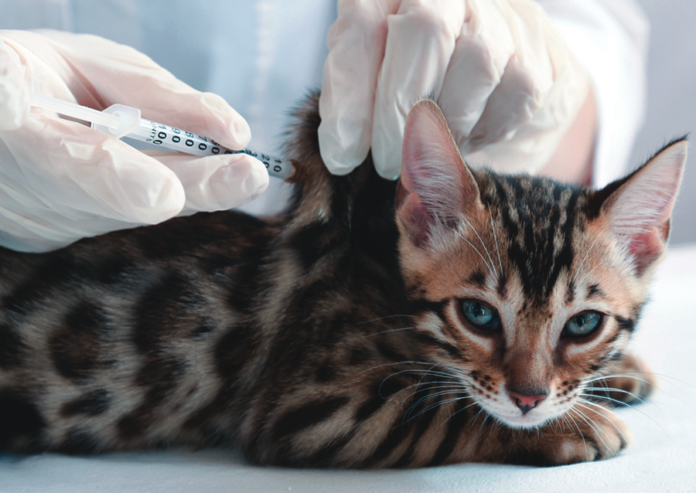Feline panniculitis is an inflammation of subcutaneous fatty tissues, which is the layer of fat just under the skin. Nodules are the most noticeable symptom. They can vary from discrete lumps to generalized plaques. They can be firm or soft, possibly with reddened skin over the top or with draining tracts or ulcers. The area may be painful. The most common site for feline panniculitis is on the abdomen or back.
Although rare, cats may develop panniculitis as a reaction to a vaccination or an injectable medication. Hair loss may occur along with a lump at the site of the injection. However, the disease may be idiopathic (no known cause) or, most often, due to a pathogen (bacteria, fungi). A fine-needle aspirate will show fat cells plus inflammatory infiltrates, although a biopsy stll may be needed for the veterinarian to make the diagnosis.
Causes
“The vast majority of feline panniculitis cases are associated with infectious agents like Nocardia, mycobacteria, or Actinomycosis (bacterial infections). The infectious agent is probably introduced into the fat by a small cut or a penetrating wound. Mycobacteria are very hard to identify in tissues, so some cases are called sterile (idiopathic) when, in fact, they are not. Culturing mycobacteria and fungal pathogens is extremely difficult and has to be done by specialty labs,” says William Miller Jr., VMD, DACVD, Professor Emeritus of Medicine, Section of Dermatology at Cornell. Special staining techniques at veterinary labs may identify these pathogens, but not always. Cultures are complicated and require extra time beyond what is expected for a routine bacterial culture.
An excessive nutritional intake of polyunsaturated fatty acids or vitamin E deficiency may cause panniculitis, but these are unusual. Pancreatitis has been associated with this skin problem in cats as well, although other clinical signs tend to predominate. Panniculitis may be secondary to a bite wound, especially if it becomes infected.
Mycobacterial cutaneous lesions in cats are often multiple pyogranulomas with fistulous tracts associated with purulent (puslike) drainage. Bacteria in this group are ubiquitous in nature, especially in water and wet soil. Many species are not pathogenic for animals under normal circumstances and are usually acquired after a trauma that results in open wounds, such as being hit by a car or a bite wound.
Pancreatitis and pancreatic tumors in the cat have been reported to cause sterile panniculitis. Cats with pancreatitis-associated panniculitis usually show signs of pancreatitis, which can be very nonspecific in cats. Cats with pancreatitis may vomit, have diarrhea, a fever, and may have a painful abdomen noticed upon palpation.
Treatment
Treatment varies with the suspected underlying cause. In the unusual case of a truly sterile panniculitis associated with pancreatitis, your cat will need to be treated for the pancreatitis first. The secondary panniculitis may then resolve on its own over time or may require surgical removal.
If diet is suspected, switching to a balanced diet and providing vitamin E supplementation may take care of mild cases.
Uncomplicated injection-related cases of panniculitis may respond to surgical removal and then be considered cured.
The prognosis for cats with opportunistic mycobacterial infections is guarded and depends mainly on early diagnosis and long-term treatment. Although some cats have been cured with fluoroquinolone antibiotic therapy alone, others require life-long treatment, as lesions may recur after what appears to be complete resolution.
What’s an Abscess?
Cats can develop a variety of lumps and bumps on their skin—cysts, tumors, pimples—but abscesses have their own distinctive characteristics.
An abscess contains pus, a yellowish fluid that forms at the site of an infection. Although pus typically contains a certain amount of cellular debris and dead tissue, it is composed mainly of white blood cells that have been summoned by the immune system to combat invading bacteria or other microorganisms.
“Because an abscess is filled with pus,” says Dr. Miller, “it will be inflamed, warm, and tender. Tumors are not usually like that, and pimples are merely superficial eruptions, affecting the outer layer of skin and minuscule by comparison to an abscess.”
An abscess can occur due to a puncture wound, but it usually results from bites from other cats, since most feline mouths contains many bacteria that can cause infection.
Pus-filled eruptions also may develop internally. A penetrating wound may puncture a cat’s liver or kidney, for instance, or the wall of the intestine. Although the wound may heal nicely on the skin surface, an abscess may form inside the body, and infection will make itself known only when the cat starts running a fever, becomes sluggish, and goes off its food.
If an internal abscess remains untreated and ruptures, bacteria and pus will pass into the bloodstream.
“With all of the toxins circulating through its body,” Dr. Miller says, “the cat becomes septicemic, and that can kill it. If the abscess ruptures externally, however, the pus will drain out and, if the wound is small enough, it will heal by itself.”




